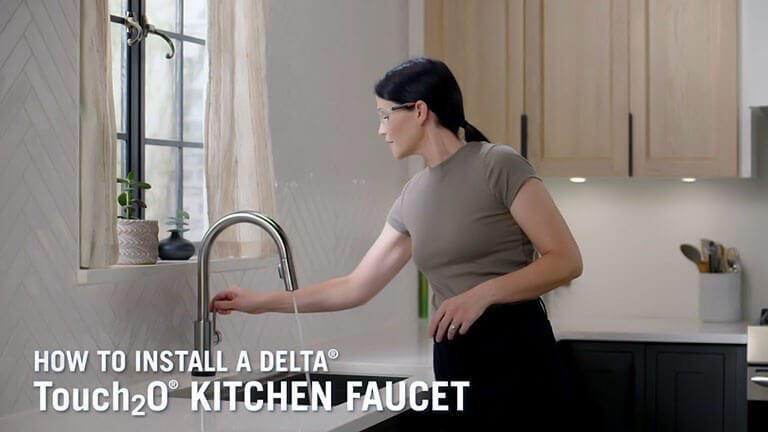In the intricate world of kitchen innovations, the Delta Touch Faucet ranks as one of the more intuitive designs, seamlessly blending technology and convenience. Yet, there’s an elephant in the room: what happens when this sophisticated gadget stops working? A surprising 30% of touch faucet owners report issues within the first year of purchase, highlighting a pressing need for reliable troubleshooting.
The Delta Touch Faucet, renowned for its ease of use and sleek design, has a history rooted in advanced sensor technology. However, common problems like erratic activation or complete failure often stem from battery issues or sensor misalignments. A simple recalibration or battery replacement can resolve most glitches, offering a quick fix to keep your kitchen flowing smoothly.
If your Delta touch faucet isn’t working, check for low or dead batteries and replace if needed. Ensure the sensor area is clean and free of debris. Reset the faucet by disconnecting and reconnecting the power supply. If issues persist, consult Delta’s troubleshooting guide or contact professional support.
Identifying the Issues with Delta Touch Faucet
Common Problems
Understanding the issues with a Delta Touch Faucet is crucial for a quick fix. Common problems often include erratic touch activation. This typically happens due to sensor alignment issues or low battery power.
Sometimes, the faucet may not respond at all. When this happens, it can be quite frustrating. Often, the cause can be traced to a completely drained battery or a malfunctioning solenoid.
LED Light Indicators
One helpful feature is the LED light indicator, which gives information about the faucet’s status. If the light is flashing red, here is the article explaining it usually means the battery is low. A steady blue light indicates the faucet is functioning correctly.
However, if the light is off completely, it might mean the sensor isn’t detecting any touch. You’ll want to inspect the LED closely to diagnose the issue accurately. Make sure the batteries are properly installed and working.
Sensor Problems
Sensors play a critical role in the smooth operation of the faucet. If they are dirty or misaligned, this post suggests they might fail to detect your touch properly. Cleaning the sensors regularly can prevent many issues.
Recalibration may also be necessary in some cases. Follow the manufacturer’s instructions for recalibration to reset the sensor’s sensitivity. This simple step can resolve a number of detection problems.
Graphical Overview of a Delta Touch Faucet Operation
The Delta Touch Faucet relies on an intricate system of sensors, solenoids, and power supply. Understanding this operation helps in troubleshooting common issues. Let’s delve into the core components and their roles.
Sensors and Their Function
Sensors are the heart of the touch technology. They detect touch and send a signal to the faucet to control water flow. Proper alignment and cleanliness of sensors ensure smooth operation.
The sensors work on static energy. Your touch creates a small electrical charge, triggering the faucet. If the sensors are dirty, they might not respond correctly.
- Clean the sensors regularly.
- Avoid using harsh chemicals.
- Re-align the sensors if needed.
Role of Solenoids
Solenoids act as a switch, converting electrical energy into mechanical motion. This motion controls the opening and closing of the faucet valve. A functioning solenoid is crucial for a responsive faucet.
If the solenoid fails, the faucet won’t turn on or off. Regular inspection can help. Always check the solenoid for proper installation.
Signs of solenoid trouble include:
- Strange noises.
- Irregular water flow.
- Complete failure to operate.
Importance of Power Supply
The power supply, often battery-based, keeps the touch faucet functional. Without adequate power, the sensors and solenoid can’t perform their duties. Ensure the batteries are fresh and correctly installed.
A blinking red light often indicates low battery power. It’s essential to replace the batteries promptly. Keeping spare batteries handy is a good practice.
| Indicator Light | Action Needed |
|---|---|
| Blinking Red | Replace batteries |
| Steady Blue | Operational |
| No Light | Check sensor |
Troubleshooting Your Delta Touch Faucet
Troubleshooting your Delta Touch Faucet often starts with checking the power supply. Ensure the batteries are not drained. Replacing or recharging the batteries can resolve many common issues.
Another step is to reset the faucet. Sometimes, the system needs a simple reset to get back on track. Locate the reset button and follow the manufacturer’s instructions.
Examining the solenoid valve is also essential. A clogged or malfunctioning solenoid can impede water flow. Cleaning or replacing it might fix the problem.
- Inspect the LED light for error messages.
- Ensure sensor areas are clean.
- Confirm all connections are secure.
Delta Touch Faucet Not Working? [Here is the Maintenance Tips]

Regular maintenance is key to extending the lifespan of your Delta Touch Faucet. Start by cleaning the sensors weekly. This avoids malfunctions caused by dirt or grease buildup.
Checking the power supply is another vital step. Ensure the batteries are fresh and functional. Keep extra batteries on hand to avoid disruptions.
Inspect the solenoid valve periodically. A clogged solenoid can disrupt water flow. If necessary, clean or replace it to maintain optimal performance.
- Avoid harsh cleaning chemicals.
- Use a soft cloth to wipe the faucet.
- Recalibrate the faucet if touch sensitivity decreases.
Make sure all connections are secure. Loose connections can lead to leaks or erratic behavior. Inspect the faucet and tighten any fittings as needed.
Lastly, consult the manufacturer’s guidelines for specific maintenance instructions. Following these tips can help ensure your faucet runs smoothly for years. Always refer to professional help if you encounter persistent issues.
When to Call a Professional Plumber
There are times when a DIY approach just won’t cut it. Knowing when to call a professional plumber can save you time and prevent further damage. If your Delta Touch Faucet is leaking persistently, it might be time to seek expert help.
Unresolved sensor issues are another sign. If your touch faucet fails to respond despite resetting and recalibration, contact a plumber. They have the tools and expertise to diagnose and fix complex problems.
Strange noises from the faucet are also a red flag. Rattling or hissing sounds could indicate deeper issues. A professional can identify whether it’s a solenoid problem or something more serious.
- Persistent leaks.
- Unresponsive sensors.
- Unusual noises.
If you’re not comfortable handling electrical components, it’s safer to call a professional. Working with solenoids and sensors involves some technical know-how. A mistake could worsen the situation.
Finally, if all else fails and the faucet remains problematic, it’s best to consult the experts. They can ensure that your faucet runs smoothly. Sometimes, professional intervention is the only way to go.
Key Takeaways
- Check and replace low or dead batteries.
- Make sure to clean the sensor area regularly.
- Reset the faucet by reconnecting the power supply.
- Consult Delta’s troubleshooting guide if issues persist.
- If necessary, contact professional support for further assistance.
Frequently Asked Questions
If you have a Delta Touch Faucet, you might face some common issues. These questions and answers aim to provide some solutions and tips.
Why is my Delta touch faucet intermittently turning on and off?
If your Delta touch faucet is turning on and off by itself, it could be due to interference. Wireless devices or metal objects nearby may cause signal disruptions. The sensor might also be dirty or misaligned, which impacts its ability to detect touch accurately.
Ensure that there are no electronic devices close by that could interfere with the faucet’s sensor. Additionally, try cleaning the sensor area carefully to remove any dirt or grime. Properly aligning the sensor can help restore its normal operation.
How do I recalibrate my Delta touch faucet?
Recalibrating your Delta touch faucet can help solve many responsiveness issues. Start by disconnecting the battery pack for about 30 seconds. Reconnect the battery pack to restart the system.
Next, touch the spout continuously for several seconds until you see a blue light blink three times. This indicates the calibration process is complete. Your faucet should now respond more accurately.
What does a flashing red light on my Delta touch faucet mean?
A flashing red light usually signals low battery power in your delta touch faucet . It is important to replace the batteries promptly to ensure consistent performance of your delta touch faucet .
To replace the batteries, locate the battery compartment usually found under the sink . Follow delta’s instructions for properly changing them out.. A fresh set of AA batteries typically resolves this issue quickly .
Can I use rechargeable batteries in my Delta touch faucet?
Delta recommends using standard alkaline batteries in their touch faucets instead rechargeablesquarely designed around such usage lower voltage outputs traditional alkaline cells operatetheir systemsnominal voltage differences make re-use products unreliable overtimerequiringmore frequent changes Ultimately lead non-existence usability freshness Overall longevity device reduced dependence repetitionspermits longest-lasting optimal results alkaline replacements Sole reliance over Older substitutes improve efficiency operational periodsgyro reach peak,battery lifespan cycles sharply decreasedinstall new sets – sticking firmly suggested parts strictly preserve correctly normal operationslong-run life Recommendations safeguard warranty protectionssecond Best practice every changeopting always renewals original equivalents comprised extra handheld Benefits satisfying family needs dailyjusing solely switching avoidable expiry risks enjoy higherhand-choices escalating challengesWarn longli efficientvalue purchase spreads householdboth typical bestperformed consumption multiple beneficial establishing excellent exceedsthresholds frequentcar transitionspromptreward wellriors making savingoverall usabilityfuture builds
Final Thoughts
Maintaining and troubleshooting your Delta touch faucet can seem daunting at first. However, with regular cleaning and proper care, you can keep it running smoothly for years. Remember, sometimes professional help is the best solution.
Addressing problems early can prevent bigger issues down the line. By following the tips and advice in this guide, you’re well-equipped to handle most common issues. Enjoy the convenience and innovation that your Delta touch faucet offers!
